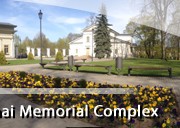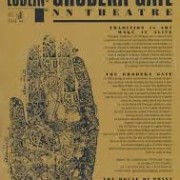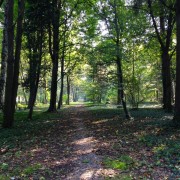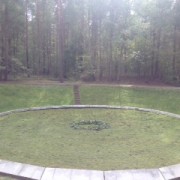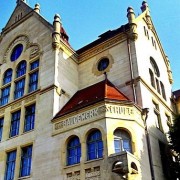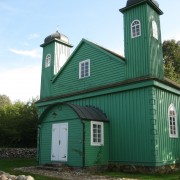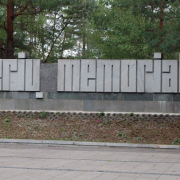Beyond the Tears, Trees and Turmoil; the Road to Reconciliation
By Megan Newell
Our two and a half week travel seminar through Lithuania and eastern Poland brought to light the importance of dialogue, art and nature as means of reconciling with the past and cultivating awareness for the future. The use of such universal, but also quite rudimentary, medians like art and nature help to facilitate a healthy and productive recovery in a way that is unlike any other. The places we visited are taking strides to help educate the population, the nation, and the world about the atrocities and happenings of, and surrounding, World War II.
Among those places was the Tuskulenai Peace Park on the outskirts of Vilnius, Lithuania. This site, one of the many places of burial (for victims of the mass shootings perpetrated by the KGB during and after World War II), is especially important to the idea of reconciliation. Not only does it help to reconcile with Russia and their involvement in these massacres, it, more importantly in my opinion, helps bring solace to those affected by the atrocities. The park itself was initially created by the Soviet officials to cover up the murders they committed from 1944 to 1947. However, in the decades after the fall of the Soviet Union, the park has been preserved. Once archaeological work was completed, Tuskulenai, was turned into a Museum, spiritual burial site, and public park. Though many may disagree, I found this approach to be both refreshing and meaningful. It serves as a place of historical importance, but in a way that allows for reflection and rebirth of a nation and people torn apart by a grave past.
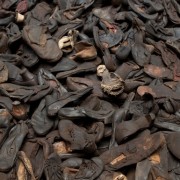
Old shoes that could be seen inside the museum at the park, which show the magnitude and reality of the death toll (http://www.jewishjournal.com/images/featured/yh_ushmm-shoes_040513.jpg )
That same day, we traveled to the Paneriai Forest, a place with a similar story of mass killings, but with a different profoundness and committed by a different perpetrator. This forest was the place in which 100,000 people (of which 70,000 were Jews) were transported to and systematically executed by members of the Nazi Regime. With that said, the Paneriai Forest was dissimilar to the Tuskulenai Park in many respects: such as it being mostly untouched by archaeologists and architects alike. Though it needs, and is in the process of getting, some sort of architectural structure to help explain and attract people to learn about the history, I believe that the untouched, organic site itself is very powerful. It, like the Tuskulenai Park, lends itself to reflection and helps one to get a better understanding of the enormity and reality of the murders themselves.

The Monument to the Jewish people who were murdered in the Paneriai Forest (https://encrypted-tbn1.gstatic.com)
After leaving Vilnius, we then traveled to Krasnogruda and Sejny, where we had the pleasure of learning, first hand, what the Borderlands Foundation has been persistently working on since 1990; “to research, revive, and nurture the cultural diversity of the Eastern borderlands of Poland” through various forms of art and education. For me, this foundation, and all others like it, is the key to reconciling and moving forward to the future with a full understanding, both culturally and historically, of the past. The founder, a wonderful man whom we had the pleasure of meeting, Krzysztof Czyzewski, holds the belief that by building bridges between different cultures and people we can learn about the past whilst simultaneously celebrating and reviving forgotten or lost cultures. His, as well as his colleagues’ work really shows how such a morose and devastating destruction of cultures does not mean that the culture is lost forever. In fact, it might just be that reviving the culture may well be the key to reconciling with the past.
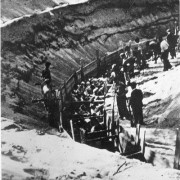
An actual picture of one the pits, encircled by the perpetrators, where the victims were shot and buried (http://www.seligman.org.il/ponar8.jpg)
Last, but not least, while in the city of Lublin we visited the Grodzka Gate. This museum ties together the raw history of World War II (the location of the Ghettos, the treatment of the Jews, the method of extermination used to annihilate them, etc.) with evidence and ties to people directly affected by the horrors. With that said the museum is involved in much more than simply educating visitors on the history of the area. It also serves as a cultural theatre called the “No Name Theatre”. This aspect of the Gate is really similar to the goals of the Borderland Foundation in that it draws on the “historical and cultural significance of its residence” and, by using art as a median, helps to uncover and revive the memory and culture of people who once lived there.
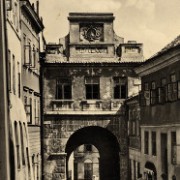
The Grodzka Gate that separated the city as it was during the war (https://encrypted-tbn3.gstatic.com)
The travel seminar really put into perspective the importance of tying together the difficult history with a means of moving forward successfully (i.e. through art, nature and dialogue). These visits helped me to get a better grasp and outlook on the magnitude and overall impact World War II had on the Jewish Community of Eastern and Central Europe. All in all, these places have done beautifully intertwining art with nature and historical context in order to stimulate the dialogue necessary for proper reconciliation.


